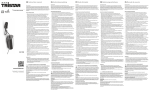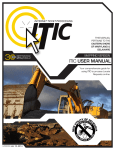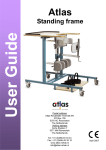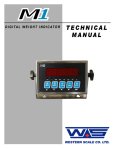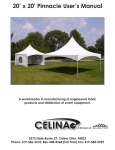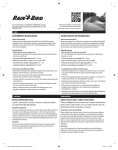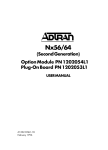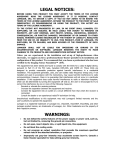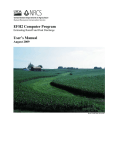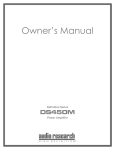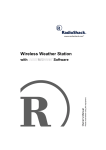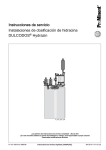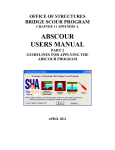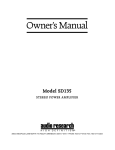Download weather emergencies - Worcester County Health Department
Transcript
FAMILY EMERGENCY PREPAREDNESS GUIDE WORCESTER COUNTY DEPARTMENT OF EMERGENCY SERVICES The Worcester County Department of Emergency Services is pleased to provide you with a copy of this Family Emergency Preparedness Guide. The Guide includes helpful information designed to assist you in preparing you and your family for emergencies. Assessments of actual incidents reveal that citizens are often the first ones to witness an event, and are first on the scene. With the information in this book, you will be better prepared in the event of an emergency. Planning for any emergency can significantly reduce the risk of injury or damage to your property. We encourage our residents to prepare themselves in event of an emergency. During major emergencies it may be up to three days before emergency providers can reach every area in Worcester County. We also encourage our residents to participate in the Community Emergency Response Training by contacting the Volunteer Services Manager at 410-632-5656. This training will help you to assist your family and neighbors in times of emergencies. We are available to provide additional emergency preparedness information and welcome invitations to make presentations to local groups or civic organizations. We can also display and distribute information at your events or activities. Please call 410632-1311 to schedule a display or presentation. Please read this Guide and implement the steps outlined to make your home and family safer. Help us in our emergency preparedness efforts; planning now will save lives and property. As always, please follow the direction of your public safety responders and tune to your local media for our emergency press releases and action messages. IMPORTANT CONTACT INFORMATION FOR EMERGENCIES ONLY DIAL 9-1-1 COUNTY AND SUPPORT AGENCY NUMBERS American Red Cross 410-749-5331 Choptank Electric 877-892-0001 Delmarva Power 800-898-8045 Eastern Shore Gas 410-524-7060 Worcester County Animal Control 410-632-1340 Worcester County Commission on Aging 410-632-1277 Worcester County Board of Education 410-632-2582 Worcester County Commissioners 410-632-1194 Worcester County Emergency Services 410-632-1311 EMERGENCY INFORMATION HOTLINE 410-632-2751 Worcester County Fire Marshal 410-632-5666 Worcester County Health Department 410-632-1100 Worcester County Public Works Roads Division Landfill Water/Wastewater 410-632-5623 410-632-2244 410-632-3177 410-641-5251 Worcester County Sheriff’s Office 410-632-1111 Worcester County Social Services 410-677-6800 LOCAL AGENCY NUMBERS Town of Berlin Police Fire Electric 410-641-2770 410-641-1333 410-641-1977 410-641-3401 Town of Ocean City Emergency Services Police Fire 410-289-8221 410-723-6616 410-723-6602 410-289-4346 Ocean Pines Association Police Fire 410-641-7717 410-641-7747 410-641-8272 Pocomoke City Police Fire Emergency Medical Services 410-957-1333 410-957-1600 410-957-2310 410-957-3600 Town of Snow Hill Police Fire 410-632-2080 410-632-2447 410-632-2110 EMERGENCY COMMUNICATIONS EMERGENCY ALERT SYSTEM (EAS) Radio: WQHQ-FM 104.7 – WSCL-FM 89.5 – WQJZ-FM 97.1 TV: WBOC-TV 16 (Cable Channel 6) – WMDT-TV 47 (Cable Channel 7) You should keep a battery powered radio or TV available to receive these broadcasts. NOAA WEATHER RADIO Salisbury 162.475 The National Weather Service activates these radios to warn of impending weather emergencies. They can also activate these at the request of the local emergency services office for other severe emergencies. ALERT SIRENS If the possibility of danger exists, your fire siren will sound a steady, two minute alert. This alarm means turn on your radio and-or television to your local channel for information broadcasts. A steady 30 second tone means the emergency is over. This is a different tone than the normal volunteer fire company alert. These sirens are tested the first Saturday of every month at approximately 10:00 am. The test siren will last for approximately one minute. EMERGENCY INFORMATION HOTLINE 410-632-2751 Worcester County Department of Emergency Services maintains an Emergency Information Hotline to keep the public informed of the current county emergency status. This line will be updated as needed in times of emergency. TABLE OF CONTENTS PREPARING YOUR HOME FOR AN EMERGENCY Recommended Supplies to include in a Basic Kit Clothing and Bedding Other Items to Consider for Your Kit Water and Food WRITING YOUR FAMILY EMERGENCY PLAN Make an Emergency Information List Fill out a Medical Information List Be Safe at Home SPECIAL CONSIDERATIONS FOR EMERGENCY PREPAREDNESS What to do for Pets in Emergencies What to do when Electrical Power is Lost PREPARING FOR WEATHER EMERGENCIES Hurricane Flood Tornado Snow Storm PREPARING FOR A TERRORIST ATTACK PREPARING FOR HAZARDOUS MATERIALS (HAZMAT) EMERGENCIES SHELTER IN PLACE OR EVACUATION SPECIAL NEEDS SURVEY (English / Español) PREPARING YOUR HOME FOR AN EMERGENCY SUPPLY CHECKLISTS Basic Supply Kit • Water (one gallon of water per person per day for drinking and sanitation) - Children, Nursing Mothers, Sick People need more water - Warm Weather will require more water - Store water in tightly sealed, clean, plastic containers (soft drink bottle) • Food (at least three day supply of non-perishable food) - Select food that require no refrigeration, preparation, or cooking - Choose foods your family will eat - Ready-to-eat canned meats, fruits, vegetable, and dried fruit - Protein or fruit bars - Dry cereals - Peanut butter - Nuts, crackers, cookies - Canned or cartoned juices • Manual can opener for food (if using can goods for food) • Battery powered flashlight and battery with extra batteries • First Aid Kit • Whistle (to signal for help) • Dust masks or cotton t-shirt (to help filter the air) • Moist towelettes for sanitation • Wrench or pliers (to turn off utilities) • Plastic sheeting, tarps, and duct tape for shelter in place • Garbage bags and plastic ties for personal sanitation and refuse • Infant/Baby formula and diapers (if applicable) Clothing and Bedding If you live in a cold weather climate, you must think about warmth. It is possible that the power will be out and you will not have heat. Rethink your clothing and bedding supplies to account for growing children and other family changes. • One complete change of warm clothing and shoes per person, including: • A jacket or coat • Long pants • A long sleeve shirt • Sturdy shoes • A hat and gloves • A sleeping bag or warm blanket for each person PREPARING YOUR HOME FOR AN EMERGENCY (continued) Other items to consider adding to your Supply Kit: • Emergency reference material such as a first aid book or a print out of this information • Rain gear • Mess kits, paper cups, plates and plastic utensils • Cash or traveler's checks, change • Paper towels • Fire Extinguisher • Tent • Compass • Matches in a waterproof container • Signal flare • Paper, pencil • Medicine dropper • Feminine supplies • Personal hygiene items • Disinfectant • Household chlorine bleach You can use bleach as a disinfectant (diluted nine parts water to one part bleach), or in an emergency you can also use it to purify water. Use 16 drops of regular household liquid bleach per gallon of water. Do not use scented, color safe or bleaches with added cleaners. Important Family Documents: Keep copies of important family records such as insurance policies, identification, medical records, and bank account records in a waterproof, portable container. This information was obtained from Ready America. You can visit the website and download other useful information from www.ready.gov. WRITING YOUR FAMILY EMERGENCY PLAN Emergency Plan Checklist For Your Family As you finish each part of your plan, note the date in the space provide below. Review and update this plan annually. Make An Emergency Information List. Date Completed: Include: • Medical and emergency contact information. • Emergency out-of-town contacts. • Names and numbers of everyone involved in your Emergency Plan. • Name and number of a relative or friend who lives more than 100 miles away from you. • If you have a communication disability, make sure your emergency information list notes the best way to communicate with you. File Out a Medical Information List. Date Completed: Include: • Medical providers • Medications you use • Adaptive equipment and/or body system support equipment you use. • Allergies and sensitivities • Communication or cognitive difficulties • Attach copies of health insurance cards and related information to your medical information list. • Keep at least a seven-day supply of essential medications with you at all times. • Have extra copies of prescriptions. • Talk with your doctor or pharmacist about what you should do if you do not have enough medicine after a disaster. Also, find out the shelf life of your medication and the storage temperature it needs. Be Safe at Home. • Install at least one smoke detector on each level of your home, outside sleeping areas. • Find the location of utility cutoff valves and switches. Become familiar with how to operate them. • Identify as many exits as possible (but at least two) from each room and from the building you are in. • Make a floor plan of your home. Include your primary escape routes. • Practice using different ways out of a building, especially if you are above the first floor in a building with many stories. • Decide what type of equipment you will need for assistance during an evacuation. • Be ready to give brief, clear, specific instructions and directions to rescue personnel. • If you do not drive, talk with your friends and family about how you will leave the area if authorities advise an evacuation. • Ask you local emergency management office if transportation services are available for people with your disability during an emergency evacuation. Find out how to arrange to get this service. • Become familiar with the emergency or disaster evacuation plan for your office, school, or any other location where you spend a lot of time. • Choose an alternate place to stay. • Have a care plan for your pet. SPECIAL CONSIDERATIONS FOR EMERGENCY PREPAREDNESS PETS What to do for your pets in an emergency: • Include your pets in your family emergency plan • Pets are NOT permitted to stay in the same Red Cross Shelters as people • Pre-arrange boarding for your animal Recommended items for a pet emergency supply kit: • An airline approved carrier for each pet • ID tags, photos, vaccination records, and registration papers • Medications with refill information (if applicable) • Muzzle and Leash • Extra supplies of food • Abundant supply of clean water • Bowls for food/water • Can opener (if needed for canned food) • Trash bags, disinfectant, blankets, towels, and other supplies needed for pet waste Additional information can be obtained from: Your local veterinarian The Humane Society of the United States 202-452-1100 Worcester County Animal Control 410-632-1340 www.hsus.org SPECIAL CONSIDERATIONS FOR EMERGENCY PREPAREDNESS (continued) What To Do When Electrical Power Is Lost • Check to see if your neighbors have power. Your loss of power could be caused by a blown fuse or tripped circuit. Report any downed power lines immediately. • Turn off all major appliances. Only leave a few light switches on in the home. • Have a plan to keep food cold. Food can be kept cold for 1 to 2 days if the doors to the refrigerator and freezer are kept closed. During prolonged power outages you may have to take other measures such as freezing water outside to place in your refrigerator or check to see if dry ice is being provided in your area. • Use flashlights and battery powered lanterns to illuminate the home. Candles and kerosene heaters present a dangerous fire hazard. • Purchase a portable emergency generator. Such a generator can provide limited electrical power during an outage. Ensure safe operation by following the user manual and consulting with your power company. Never operate a generator inside your house or attached garage due to carbon monoxide fumes. • Keep your car fuel tank at least 3/4 full at all times. Power outages can affect gasoline pumping stations. • If you have a well, use alternate sources of water. Water systems with electrical pumps will not operate when the power is out. • Be prepared for gas appliances to be inoperable. Some appliances require electricity for ignition or valve operation. • Shut off the power circuit to your water heater if the tank has been drained. • Drain pumps, supply lines, water heaters, boilers and traps in tubs, sinks, commodes, washers and dishwashers. Plumbing can freeze when power is lost during cold weather. • Have a contingency plan for those with life support equipment. Decide upon an alternate power source for the device and method of relocating the person. DO NOT APPROACH, MOVE OR TOUCH ANY DOWNED LINES – CALL YOUR LOCAL UTILITIES!!! WEATHER EMERGENCIES Worcester County is vulnerable to a number of weather-related hazards, which the public should be prepared for, to protect their families and their property. The National Weather Service (NOAA) issues Watches and Warnings by NOAA Weather Radio and EAS activation. Your local media and emergency services office may refer to this terminology. Purchase a NOAA weather radio with battery backup and tone alert feature that automatically alerts you when a Watch or Warning is issued. KNOW THE DIFFERENCE WATCH – AN INCIDENT IS POSSIBLE. WATCHES ARE ISSUED 12 TO 36 HOURS IN ADVANCE OF AN EVENT. WARNING – A SERIOUS WEATHER EVENT IS OCCURRING OR WILL OCCUR SOON. IT IS ADVISED TO TAKE PROTECTIVE ACTIONS IMMEDIATELY!!! FLOOD Residents in many areas of Worcester County are prone to flooding. It is important to take action BEFORE a flood occurs. Many deaths occur each year from persons attempting to drive through flood waters. Flood waters can be deceptive. They hide road conditions. Also slow moving water can float a vehicle away easily. “DON’T DROWN---TURN AROUND!!!” HURRICANES Worcester County has not sustained a “direct-hit” from a hurricane; however, we have had significant damage as these storms pass near to our coast and westward toward the Chesapeake Bay. The Hurricane Season is defined from June 1 to November 30 and you should be aware of the potential for severe wind and water damage from these events. Preparations should be made in advance to secure your home, remove or secure outside objects, and for the possibility of evacuation during this time period due to the hurricane potential. Maryland Emergency Management Agency produces a Hurricane Preparedness Guide which is available online at www.mema.state.md.us or from the Worcester County Department of Emergency Services. TORNADOES Although we are not a high risk area for tornadoes compared to other sections of the country, destructive tornadoes can occur in Worcester County. These also occur frequently after hurricanes pass the area. If a TORNADO WARNING is issued, meaning a tornado has been sighted or indicated by weather radar; protective actions should be immediately taken. Move to a basement or interior room or hallway on the lowest floor. Stay away from windows. If in a vehicle, leave the vehicle and lie flat in a ditch or depression. Mobile homes offer little protection from tornadoes and should be abandoned immediately! SEVERE STORMS All of Worcester County is vulnerable to severe storms. A blizzard or substantial snowfall, ‘northeaster’, or thunderstorm could occur which have the potential for injuries, death, or property damage. As with other hazards, being prepared is critical. These storms can cause loss of electrical power or other services for several days. It is important to monitor these events and follow the advice of public safety officials. PREPARING FOR A TERRORIST ATTACK Terrorism is the use of force or violence against persons or property in violation of the criminal laws of the United States for purposes of intimidation, coercion or ransom. Terrorists often use threats to create fear among the public, to try to convince citizens that their government is powerless to prevent terrorism, and to get immediate publicity for their causes. High-risk targets include military and civilian government facilities, international airports, large cities and high-profile landmarks. Terrorists might also target large public gatherings, water and food supplies, utilities and corporate centers. Furthermore, terrorist are capable of spreading fear by sending explosives or chemical and biological agents through the mail. In the immediate area of a terrorist event, you would need to rely on police, fire and other officials for instructions. However, you can prepare in much the same way you would prepare for other crisis events. Steps to take in the event of an attack: • Remain calm and patient. • Listen to your local Emergency Alert System stations for directions from local officials. • If the disaster occurs near you, check for injuries. Give First Aid and get help for seriously injured people. (Before rendering First Aid be sure victim is not contaminated. Avoid direct contact if contamination is suspected.) • If the disaster occurs near your home while you are there, check for damage using a flashlight. Do not light matches or candles or turn on electrical switches. Check for fires, fire hazards and other household hazards. Sniff for gas leaks, starting at the water heater. If you smell gas or suspect a leak, turn off the main gas valve, open windows, and get everyone outside quickly. • Shut off any other damaged utilities. • Confine or secure your pets. • Contact your family. Do not use the telephone again unless it is a life-threatening emergency. • Check on your neighbors, especially those who are elderly or disabled. PREPARING FOR A TERRORIST ATTACK (continued) Identifying Suspicious Packages & Envelopes To report suspicious activity that is non-emergency in nature call: Inappropriate or unusual labeling • Excessive postage • Handwritten or poorly typed addresses • Misspellings of common words • Strange return address or no return address • Incorrect titles or title without a name • Not addressed to a specific person • Marked with restrictions, such as “Personal”, “Confidential,” or “Do No X-Ray” • Marked with any threatening language • Postmarked from a city or state that does not match the return address Appearance • Powdery substance felt through or appearing on the package or envelope • Oily stains, discolorations or odor • Lopsided or uneven envelope • Excessive packaging material such as masking tape, string, etc. Other suspicious signs • Excessive weight • Ticking sound • Protruding wires or aluminum foil If a package or envelope appears suspicious, DO NOT OPEN IT! Contact the proper authorities. Source: www.ready.gov The Maryland Coordination and Analysis Center at 800-492-8477 Or The Maryland Emergency Management Agency at 877-MEMA-USA PREPARING FOR A HAZARDOUS MATERIALS (HAZMAT) EMERGENCY Questions About Hazmat Emergencies: What to do During a Hazmat Emergency Q: Why are there so many incidents involving hazardous materials in industries? Depending on the situation, emergency personnel could ask you to Shelter-in-Place or Evacuate. Stay calm. Familiarize yourself with this booklet so you will be better prepared. If your neighbors are elderly, disabled or have small children, they may need your assistance. It is critical you monitor your local Emergency Alert System (EAS) Stations for the latest information and official instructions. With a relatively minor chemical incident, you should go indoors unless otherwise directed by emergency personnel. Remain inside until local officials report conditions are all clear. A: There are not, really. Far more incidents occur at home, at the office or in transit than occur at business facilities which manufacture or use hazardous materials. You may hear about industrial incidents because they have the potential to affect many people. Since these incidents are relatively rare, especially considering the frequency of other hazards like auto accidents or acts of violence, they capture our curiosity and make the headlines. Q: Why do we even have hazardous materials, and, how are they used? A: Because as consumers, we want the products that are made from these materials. We have lighter, more efficient vehicles, lifesaving medicines, wrinkle free clothing and flameretardant plastics because of the hazardous chemicals necessary in their manufacturing. If you are home... • Close all doors and windows, placing damp towels around any sills or openings. • Turn off your heating or air system. Close all vents. • Do not use your fireplace and make sure to close the dampers. If you are outside and cannot go indoors... Q: What is being done to reduce the impact of a chemical spill? A: Your emergency services agencies, law enforcement, fire and EMS have training in response to chemical incidents. Additionally, Worcester County’s Department of Emergency Services and Local Emergency Planning Committee has a response plan that is coordinated with other area departments in addition to municipal, state and federal response plans. All of these plans and responders work with industries to reduce the impact of potential chemical releases. • Stay upwind, if possible, and stay out of low areas; or move crosswind so the wind blows from your left or right but not in your face or from behind. • In a chemical incident, you may be directed to leave and given specific route instructions. If no route is given, use the shortest path out of the area. Please read the shelter-in-place and evacuation procedures on the next page for more information. Worcester County’s Local Emergency Planning Committee meets quarterly each fourth Thursday (January, April, July, October) at 9:00 a.m. This meeting is open to the public. Call 410-632-1311 for additional information on these meetings. SHELTER-IN-PLACE OR EVACUATION? Shelter-In-Place Evacuation Whether you are at home, work or elsewhere, there may be situations when it’s simple best to stay where you are and avoid any uncertainty outside. There may be conditions under which you will decide to get away, or there may be situations when you are ordered to leave. Plan how you will assemble your family and anticipate where you will go. Choose several destinations in different directions so you have options in an emergency. There are other circumstances when staying put and creating a barrier between yourself and potentially contaminated air outside is a matter of survival. This process is known as “shelter-inplace.” Use available information to assess the situation. If you see large amounts of debris in the air, or if local authorities say the air is badly contaminated, you may want to take this kind of action. Shelter-in-place procedures: • Bring your family and pets inside. • Lock doors, close windows, air vents and fireplace dampers. • Turn off fans, air conditioning and forced air heating systems. • Take your emergency supply kit, unless you have reason to believe it has been contaminated. • Go into an interior room with few windows, if possible. • Seal all windows, doors and air vents with plastic sheeting and duct tape. Consider measuring and cutting the sheeting in advance to save time. • Be prepared to improvise and use what you have on hand to seal gaps so that you create a barrier between yourself and any contamination. • Local authorities may not immediately be able to provide information on what is happening and what you should do. However, you should watch TV, listen to the radio or check the internet often for official news and instructions as they become available. Create an evacuation plan: • Plan places where your family will meet, both within and outside of your immediate neighborhood. • If you have a car, keep 3/4 tank of gas in it at all times in case you need to evacuate. • Become familiar with designated local shelters, alternate routes and other means of transportation out of your area. • If you do not have a car, plan how you will leave if you have to. • Take your emergency supply kit unless you have reason to believe it has been contaminated. • Lock the door behind you. • Take your pets with you, but understand that only service animals may be permitted in public shelters. • Plan how you will care for your pets in an emergency. Learn how and when to turn off utilities: • Located the electric, gas and water shut-off valves. • Keep necessary tools near gas and water shut-off valves. • Teach family members how to turn off utilities. • If you turn the gas off, a professional must turn it back on. Do not attempt to do this yourself. EMERGENCY SPECIAL NEEDS We are concerned for those persons in our community who may have special needs during emergency situations. As part of our planning process, we are attempting to obtain information about these families. Please complete and return the emergency special needs survey on the page below. This will allow specific departments and agencies to contact these persons to aid them in preparing for an emergency. The survey does not imply that Worcester County departments, personnel, and mutual-aid agencies will provide any special responses to the recorded address. Our goal is to assist those residents in making a pre-planned family emergency preparedness plan. Emergency Special Needs Survey In order to determine the special needs of county residents during an emergency, please complete the questionnaire below. Information received through the Emergency Needs Survey, may be maintained in a confidential database in the Emergency Operations Center. If you have any questions about this form please call the Worcester County Department of Emergency Services at 410-632-1311. Cut form here and return to the address below. Check the box beside those items which apply to you or anyone living in your home. Please mark ALL boxes that apply to any person who lives in your home. ❑ ❑ ❑ ❑ Cannot hear (hearing disability). Cannot see well or cannot see (blind). Cannot walk around well or needs help to move around. Cannot understand English and no one nearby to interpret. List language(s) spoken: ❑ Need an ambulance or medical care to leave home. DESCRIBE: ❑ Need a special vehicle to leave home (wheelchair van, etc.). DESCRIBE: ❑ Need a ride (transportation not available or cannot ride with a friend, family or neighbor). Number of persons needing a ride: ❑ Other needs: If you checked off any items showing that you or someone in your household needs help during an emergency, please fill out the following: PLEASE PRINT Name(s): Street Address: City: State: ✄ Telephone Number: Name/Telephone Number of person, completing form: Zip Code: Is it unlisted? Return form to: Worcester County Dept. of Emergency Services 1 West Market St., Room 1002 • Snow Hill, MD 21863 YES NO ✄ NECESIDADES ESPECIALES DE LA EMERGENCIA Estamos preocupados por esas personas en nuestra comunidad que puedan tener necesidades especiales durante situaciones de emergencia. Como parte de nuestro proceso de planeacion, estamos tratando de obtener información sobre estas familias. Por favor complete la encuesta sobre necesidades especiales de emergencia en la página abajo. Esto permitirá a los departamentos y agencias específicas a entrar en contacto con estas personas para ayudarles en la preparación de una emergencia. La encuesta no implica que los departamentos, personal y agencias de asistencia mutual del Condado de Worcester proporcionarán cualquier respuesta especial a la dirección registrada. Nuestra meta es asistir a estos residentes en la preparación de un plan de emergencia para la familia. Encuesta de Necesidades Especiales en Una Emergencia Para poder determinar las necesidades especiales de los residentes del condado durante una emergencia, por favor liene este questionario. La información recibida por medio de este questionario se mantendrá en una base de datos confidenciales en el Centro de Operaciones de Emergencias. Si usted tiene alguna pregunta sobre esta forma por favor llame a el Departmento de Servicios de Emergencias del Condado Worcester al número 410-632-1311. La forma del corte aquí y vuelve a la dirección abajo. Por favor seleccione TODOS los puntos que le apliquen a cualesquier persona que viva en su hogar. ❑ ❑ ❑ ❑ No puede oir (incapacitado del oido). No puede ver bien ó no puede ver (siego). No puede caminar bien ó necesita ayuda para mobilizarse. No habla inglés y no tiene un interprete cerca. Escriba el idioma que habla: ❑ Necesita una ambulancia ó cuidado médico para salir de casa. DESCRIBA: ❑ Necesita un vehiculo especial para salir de casa (van para silla de ruedas, etc.). DESCRIBA: ❑ Necesita transportación (no está disponible ó no tiene un amigo, meimbro de familia ó vecino que le ayude). Númbero de personas que necesitan transportación: ❑ Otras necesidades: Si usted seleccionó algún punto anterior diciendo que alguien en su hogar necesita ayuda durante una emergencia, por favor llene esta información: ESCRIBA CON LETRA DE MOLDE Nombre(s): Dirección: Ciudad: Estado: Númbero de Teléfono: Nombre/Teléfono de la persona que llenó esta forma: Codigo Postal: ¿Es privado? Vuelva forma a: Worcester County Dept. of Emergency Services 1 West Market St., Room 1002 • Snow Hill, MD 21863 YES NO Be prepared for all types of emergencies... FLOOD FIRE HAZARDOUS MATERIALS TERRORISM HURRICANE TORNADO Photos courtesy of: Worcester County Department of Emergency Services, Worcester County Fire Marshal’s Office, NOAA--National Weather Service, C.B. “Buzz” Melton and North Carolina Division of Emergency Management| Hazard Mitigation Section.



















